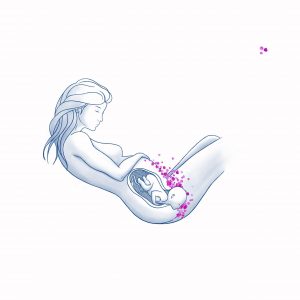The development of the baby’s microbiota
What is the microbiota?
This microbiota is all of the bacteria present in our intestines. The establishment of a balanced microbiota is essential for the child’s health and for the development of natural defences in particular1.
Discover the first stages in the development of the infant’s intestinal microbiota:
1st stage: Birth 1-3
At birth, the baby has its first encounter with the outside world, and in particular the bacteria within it. This is the moment at which the microbiota begins to develop.

When a baby is born naturally, it is delivered through the vagina. In this case, the baby comes into direct contact with bacteria of maternal origin.

When a baby is born by caesarean section, it is delivered through the mother’s abdomen, not her vagina. As a result, it does not come into contact with the mother’s bacteria, but with bacteria from the outside world. These bacteria are fewer and less adapted to the needs of the baby. The development of the baby’s microbiota is therefore delayed.
When a baby is born by caesarean section, it is delivered through the mother’s abdomen, not her vagina. As a result, it does not come into contact with the mother’s bacteria, but with bacteria from the outside world. These bacteria are fewer and less adapted to the needs of the baby. The development of the baby’s microbiota is therefore delayed.

Stage 2: nutrition4-5
Breast milk provides the infant with the best nutrition for microbiota development. It contains:


Prebiotics: These are sugars that are not digested by the body and which feed good bacteria in the intestine, allowing them to develop more easily

The probiotics and prebiotics in breast milk act in synergy to strengthen your baby’s natural defences and intestinal microbiota.
Does antibiotic treatment have an effect on the development of the microbiota?
Yes! Antibiotics are prescribed to eliminate certain disease-causing bacteria. However, repeated antibiotic treatment may also destroy some or all of the good bacteria and therefore disrupt the balance of the intestinal microbiota6. Find out more
Stage 3: Contact with parents and relatives7

The contact between your baby and your skin, especially your breast, contributes to the transmission of microorganisms that promote optimal growth. Skin-to-skin contact should therefore be practised from your baby’s arrival.
Thanks to the outside world and dietary diversification, the microbiota becomes established in the baby’s stomach.
It reaches maturity when the child is 3 years of age and continues to evolve throughout his/her life.
- Worepeis H., et al, The first thousand days – intestinal microbiology of early life: establishing a symbiosis, Pediatr Allergy Immunol, 2014; 25: 428-38.
- Butel MJ, et al. The developing gut microbiota and its consequences for health. J Dev Orig Health Dis. 2018; 22: 1-8
- Tanaka et al., Development of the gut microbiota in infancy and its impact on health in later life. Allergology International. 66 (2017) 515-522
- Jeurink PV. Et al., Human milk: a source of more life than we imagine. Benef Microbes. 2013; 4: 17-30
- Ballard O, et al., Human milk composition: nutrients and bioactive factors. Pediatr Clin North Am 2013; 60: 49-74
- Shamir R, van Eldburg Knol J Duponent C (eds). Gut health in Early Life: Significance of the gut Microbiota and Nutrition for Development and Future Health 2015; John Wiley and Son, West Sussex, UK.
- Moore E., et al., Early skin-to-skin contact for mothers and their healthy newborn infants, Cochrane Database Syst Rev. Author manuscript; available in PMC 2014 April 08.
BA20-856


